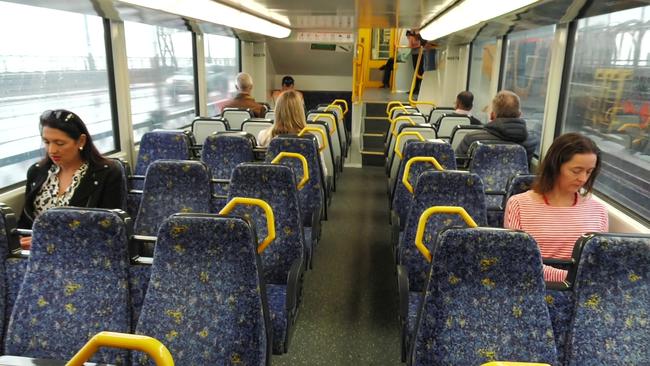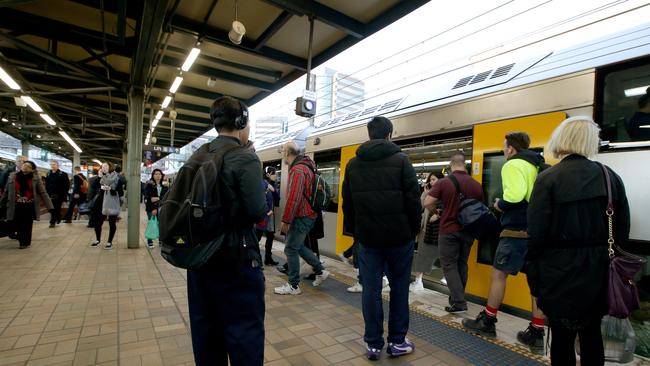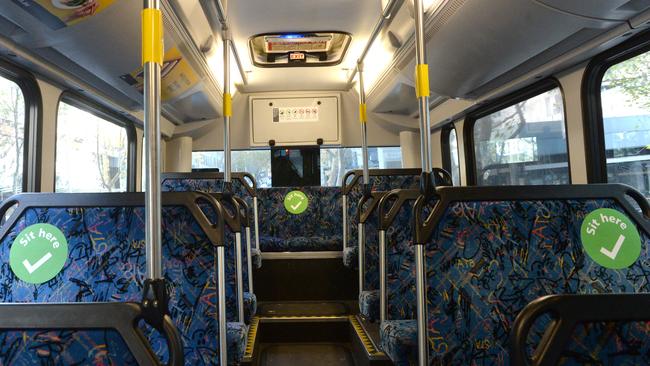Sydney trains, buses: City set for return as public transport limits double
More city workers are set to return to the office with extra commuters allowed on public transport from July 1 after an easing of strict COVID-19 capacity limits. Meanwhile, three new cases of COVID-19 were diagnosed by NSW health yesterday. All were in returned travellers in hotel quarantine.
NSW
Don't miss out on the headlines from NSW. Followed categories will be added to My News.
- Public transport cleaning spree to combat COVID-19
- How much you can expect to pay for interstate flights
Extra commuters will be allowed on public transport from July 1, with an easing of strict COVID-19 capacity limits.
Waratah trains will be able to carry 68 customers per carriage - more than double the current limits. Most buses will see their capacity almost double to 23.
A freshwater ferry will be able to carry 450 customers, up from 245.
The Premier said commuters should still try to avoid peak hour, if they can, but the restrictions are being eased as more people prepare to return to work.
“From 1 July, half of the capacity on public transport will resume,” she said.
Transport minister Andrew Constance said the capacity boost means the network will be able to cater for 1.3 million commuters across the day, if journeys are spread out.
Meanwhile, three new cases of COVID-19 were diagnosed by NSW health yesterday. All were in returned travellers in hotel quarantine.
New data revealed last week shows NSW residents are venturing onto public transport in growing numbers as the state moves out of lockdown, sparking concerns about how the system will cope in the future.
Ms Berejiklian continued to encourage commuters to stagger their shift times. Buses and trains would continue to be cleaned at least thrice daily.
“This is pleasing for those people who work in places like the CBD or people who do rely on public transport,” Ms Berejiklian told reporters.
“We’re still encouraging people to travel outside the peak where possible, but now we will have extra capacity in the peak, almost doubling capacity.
Opal card usage data from Transport for NSW shows the number of people boarding bus, train, light rail and ferry services across Sydney spiked last month.
The data seen by The Daily Telegraph shows public transport use doubled on some services as kids returned to school and restaurants reopened last month.
Train use alone rose more than 52 per cent in May compared to the month prior with than 9 million people boarding NSW Trainlink and Sydney Train services as confidence in the flattening of the curve grew.
In terms of individual services, the T4 Eastern Suburbs Illawarra Line was by far the busiest train line in May, with 1,832,000 trips undertaken, followed by the T1 Western Line at 1,391,000 and T1 North Shore Line with 1,067,000.
Meanwhile, the Olympic Park line took the biggest hit from COVID-19, becoming the least used train line in the state, with just 15,000 trips, even less than the Southern Highlands Line, which had 22,000 commuters.
SCROLL TO THE BOTTOM TO CHECK YOUR SERVICE


The overall optimism about the flattening of the curve was also felt in the use of the state’s buses, with 7.7 million passengers logging their trips with Opal, an increase of 52 per cent on April.
The most used bus services for May were the CBD and Eastern Suburbs services, followed by the Inner West, Strathfield and Burwood region and the North Shore, Chatswood and Epping bus services.


Sydney’s famous ferry service also welcomed thousands of commuters, with 203,000 people boarding their services - a more than 120 per cent increase on April.
The popular F1 Manly service had the most commuters, followed by the F4 Cross Harbour service and the F3 Parramatta River.
Light rail usage across the Sydney and Newcastle services also surged - a whopping 90 per cent jump since April, with 443,000 people tapping their cards on the service.
The Sydney Metro was a favourite for commuters with almost half a million trips, followed by the L1 Dulwich Hill line which had 146,605 trips, followed by the L2 Randwick and L3 Kingsford.

While Opal card use across Sydney’s bus, train, light rail and ferry services has increased in recent months, overall use is still down by at least 70 per cent compared to business as usual levels in May last year.
Professor Graham Currie, public transport expert at Monash University said this presents a problem when more people venture outside when lockdowns are lifted in July.
Unless people continue to work from home, most commuters will have “no choice” but to breach social distancing rules on transport, he warned.
“To some extent the policy which has been set is unrealistic. It’s designed in a way which will make breaking social distancing highly likely,” he said.

With 60 per cent of commuters in Sydney CBD travelling by public transport, he says the only solution is for most employees to continue to work from home, find another way to get to work or for planners to incentivise non-peak travel.
Another transport expert, Professor David Levinson from the University of Sydney, said the only way to maintain social distancing if demand grows is for the virus to be eradicated - and capacity limits removed.
“If there is no more COVID-19 in NSW, we should not be constrained by social distancing. People concerned can of course wear masks and reduce talking on buses and trains,” he said.
The figures come as Peter Khoury, spokesman for the NRMA flags concerns the city’s roads could become gridlocked if public transport levels do not return to their pre-COVID levels soon.
He said the reduction in public transport usage has been felt heavily with increased traffic - a problem that could be worsened when lockdowns are fully lifted in July.
“The limits on public transport will be a burden on the road network and we’re going to have to carry more of a share until we get back to some normality. That’s going to require considerable patience from drivers,” he said.
Sydney’s busiest public transport services by Opal trip (May, 2020)
Train
1. T4 Eastern Suburbs and Illawarra - 1,832,000
2. T1 Western - 1,391,000
3. T1 North Shore - 1,067,000
4. T2 Leppington - 952,000
5. T8 Airport and South - 910,000
6. T3 Bankstown - 789,000
7. T2 Inner West 667,000
8. T9 Northern - 615,000
9. Central Coast Newcastle - 381,000
10. T5 Cuymberland - 223,000
11. Hunter Line 25,000
12. Southern Highlands 22,000
13. T8 Olympic Park 15,000
Buses
1. Sydney CBD and Eastern Suburbs - 1, 672,000
2. Inner West and Strathfield, Olympic Park - 1,635,000
3. North Shore, Chatswood and Epping - 839,000
4. Northern Beaches - 821,000
5. Penrith, Mount Druitt and Richmond - 498,000
6. Castle Hill, Blacktown - 510,000
7. Fairfield, Liverpool - 465,000
8. Bankstown - 345,000
9. Glenfield - 161000
10. Terrey Hills - 141,000
11. Campbelltown - 139,000
12. Hornsby, Berwora and Gordon - 96,000
Light Rail
1. Sydney Metro - 449,284
2. L1 Dulwich Hill Line - 147,000
3. L2 Randwick - 144,0000
4. L3 Kingsford - 133,000
5. Newcastle Light Rail - 19,652
Ferry
1. F1 Manly - 59,599
2. F4 Cross Harbour 53,565
3. F3 Parramatta River 29,916
4. 118 Newcastle - 151,131
5. F6 Mosman Bay - 13,082
6. F8 Cockatoo Island - 10,283
7. F5 Neutral Bay - 9,897
8. F2 Taronga Zoo - 7,992
9. F7 Double Bay - 3,936
